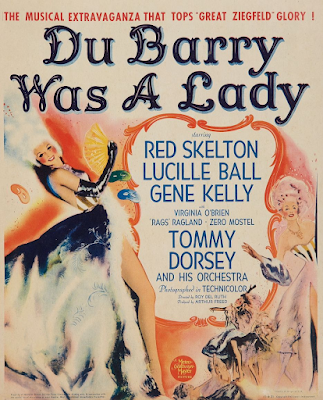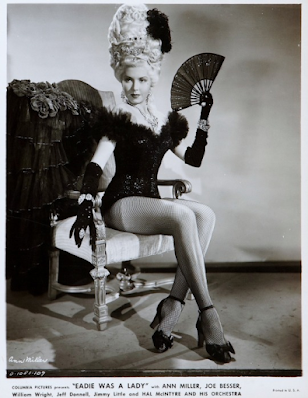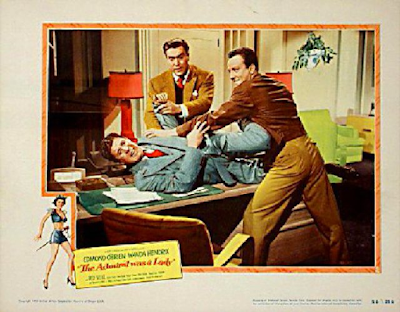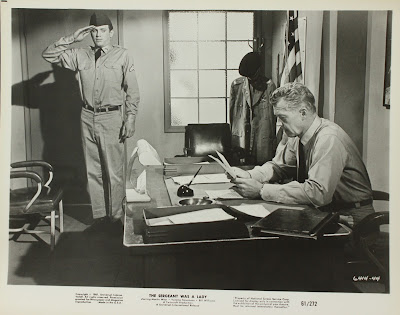Wonderland Burlesque's
Let's All Go To The Movies:
The 'Was A Lady' Edition
But today, we're looking 'past tense', as in, 'was a lady'.
Yep, all six of these films share one thing in common...
They are all fabulous Hollywood fun.
With the promise of a little dish, let's dig in.
Sheila Vane, daughter of Stanley, an English aristocrat, and Alice, a former maid of the Vane family, has displayed the traits of her aristocratic heritage since childhood. While living in Acoola, Montana, where the couple settled after Stanley's family shunned him for his marriage to a woman not of his class, Stanley persuades his daughter to return someday to England and reclaim her rightful place in the Vane home. Sheila takes a job as a riding instructor at a dude ranch in order to fulfill her father's wishes, and there meets Tommy Traill, a young and reckless Eastern playboy, who immediately falls in love with her charming combination of Western ruggedness and English good breeding. Sheila befriends Tommy, but when he proposes to her, she chides him for his tendency toward drink and tomfoolery. Sheila urges Tommy to go to South America, where his father, who owns fruit plantations, has promised him a chance to make a success of himself. Stanley, meanwhile, is killed while trying to save a horse during a barn fire, leaving Alice penniless. Sheila gives her mother the $600 her father had saved for her trip to England, then leaves home. Sheila takes a job as a trick rider at a circus, where she meets Jerry Couzins, a confidence man who is working as the circus publicist. Before she finally embarks for England, Shelia meets Tommy in New York and promises to come back to him. In England, Shelia arrives at Vane Manor and is received coldly by her Aunt Diana and Uncle George. As their daughter will be presented at court soon, they feel that news that Shelia's maternal grandfather is still the family butler and her mother their former maid must not resurface. Sheila leaves despondent, and back in New York, Tommy takes her to the Traill house to meet his father. Mr. Traill rejects Sheila as a potential marriage partner for his son because of her class. In a passionate speech, Sheila reveals her background and states her own ideas about class, that honesty and decency are more important than station. Sheila then refuses to marry Tommy until Mr. Traill asks her, as not to suffer the same fate as her parents. The couple breaks up, and two weeks later, Sheila meets Jerry at her hotel and accepts his offer of a job inducing rich men to gamble at the nightclub he runs. Two months later, Tommy enters the club drunk and accuses Sheila of seeing Jerry throughout their own romance. Angered by Tommy's appearance, Sheila lies that she intends to marry Jerry, but after Jerry and Tommy fight, Sheila brings an unconscious Tommy home to his father, who finally asks her to marry his son. She refuses at first, telling the elder Traill what she has now become, but he informs her that it doesn't matter anymore. The reunited couple embraces and decides to marry the next day.
Based on the 1934 novel She Was a Lady by Elisabeth Cobb, this American drama was directed by Hamilton MacFadden, written by Gertrude Purcell, and stars Helen Twelvetrees, Donald Woods, Ralph Morgan, Monroe Owsley, Irving Pichel and Doris Lloyd. The film was released on August 22, 1934, by Fox Film Corporation.
Helen Twelvetrees was an American actress. She starred in Hollywood films in the sound film era from 1929 to 1939. Many of her roles were of 'suffering women', which reflected her tumultuous personal life.
Twelvetrees was married three times. She married her first husband, actor Clark Twelvetrees, in February 1927. During the marriage, her husband attempted suicide in the middle of a dinner party by jumping out of a Manhattan hotel window. He struck two awnings before landing on a parked taxi and was hospitalized for several months. In March 1930, she filed for divorce, citing mental cruelty. During the divorce trial, Twelvetrees claimed that her husband was an alcoholic who was drunk when they married and beat her on four occasions. Their divorce became final in March 1931. Clark Twelvetrees died in August 1938 of a skull fracture after striking his head on a curb when a man, who witnessed Clark hit a woman with whom he was arguing, physically intervened. Murder charges against the man, 29-year-old painter James Paskovics, were dismissed.

On February 13, 1958, Twelvetrees was found unconscious on the floor of her living room at her home in Middletown, PA, a suburb of Harrisburg. She was taken to Olmstead Air Force Base Hospital in Middletown, where she died. According to the county coroner, Twelvetrees had been suffering from a kidney ailment for some time and took an overdose of sedatives. Her death was ruled a suicide.
Ann Sothern and Lew Ayres
--- ---
Hat-check man Louis Blore is in love with nightclub star May Daly, who is in love with a poor dancer, though she really wants to marry for money. When Louis wins the Irish Sweepstakes, he asks May to marry him and she accepts although she doesn't love him. Soon after, Louis has an accident and gets knocked on the head, causing him to dream that he's King Louis XV pursuing the infamous Madame Du Barry.
Based on the 1939 stage musical of the same name, this American musical comedy film directed by Roy Del Ruth, and stars Red Skelton, Lucille Ball, Gene Kelly, and Tommy Dorsey and His Orchestra. Shot in Technicolor, the film was produced and distributed by Metro-Goldwyn-Mayer.
Musical numbers featured Tommy Dorsey and His Orchestra (featuring Buddy Rich and Ziggy Elman), Dick Haymes, Jo Stafford, The Pied Pipers, Six Hits and a Miss, and the Music Maids.
The period French dream sequences in this film gave MGM the opportunity to re-use many of the sets, furnishings, costumes, props that had originally been created for their lavish 1938 bio-pic Marie Antoinette, which starred Norma Shearer and Tyrone Power.
Lucille Ball was so impressed with cinematographer Karl Freund, who worked on this film, that she later hired him to shoot I Love Lucy.
Edithea Alden, a college girl from a wealthy family, is working as dancer in a nightclub. When the leading lady, Rose, is losing customers, Editha is given her job, but, due to the fact that her double life could be discovered, she quits and the nightclub is forced to close. In college she gets a role in the annual college show. The ex-nightclub owner finds out who his star really was, and wins her back, Unfortunately, on the night of the club's reopening, the club is raided and they are all arrested. Upon learning that she's been arrested, the college moves to expel her. Who will save the day?
This American musical comedy was directed by Arthur Dreifuss and stars Ann Miller, Joe Besser, William Wright, Jeff Donnell and Jimmy Little.
Ann Miller was 22 years old when she made this, her 24th film! She appeared in four films the previous year and two in 1945. Certainly keeps a gal on her toes!
Despite the first name, Jeff Donnell is a woman. A reliable featured player and occasional co-star who, On a rare occasion, found herself in 'A' pictures, most notably the Bogart film noir classic In a Lonely Place (1950), but more often than not she played the obliging or supportive friend of the leading lady. Unable to break away from her established 'B' movie ranking, she later tried a move to RKO Studios (1949) but fared no better there.
--- ---
The US army stations a single male sergeant on an island with 125 members of the Women's Air Corps Corps! One man's dream is another man's nightmare!
This American comedy film written and directed by Bernard Glasser and stars Martin West, Venetia Stevenson, Bill Williams, Catherine McLeod, Roy Engel, and Gregg Martell. It was released on October 4, 1961, by Universal Pictures.
Born in 1938 in London, England, Venetia Stevenson was the daughter of film director Robert Stevenson and actress Anna Lee. The family moved to Hollywood within a year of her birth after her father signed a contract with film producer David O. Selznick. When her parents divorced in 1944, she stayed with her father and new stepmother, Frances. After an education in exclusive Californian private schools, her theatrical debut was with her mother in Liliom, a play produced by the Sombrero Theater, in Phoenix, Arizona, in April 1955 and with the husband-and-wife team of Fernando Lamas and Arlene Dahl.
--- ---
--- ---
She Was A Lady
(1934)
Twelvetrees was married three times. She married her first husband, actor Clark Twelvetrees, in February 1927. During the marriage, her husband attempted suicide in the middle of a dinner party by jumping out of a Manhattan hotel window. He struck two awnings before landing on a parked taxi and was hospitalized for several months. In March 1930, she filed for divorce, citing mental cruelty. During the divorce trial, Twelvetrees claimed that her husband was an alcoholic who was drunk when they married and beat her on four occasions. Their divorce became final in March 1931. Clark Twelvetrees died in August 1938 of a skull fracture after striking his head on a curb when a man, who witnessed Clark hit a woman with whom he was arguing, physically intervened. Murder charges against the man, 29-year-old painter James Paskovics, were dismissed.
Twelvetrees married again in April 1931, this time to WWI Marine Corps veteran Frank 'Jack' Bryan Woody. Woody was a Hollywood stuntman and realtor, who would later become a full-time actor and seasonal hunting guide in California's Sierra Nevada. The two met on set while filming Her Man (1930) in Havana, Cuba. They had a son, Jack Bryan Woody, born October 1932. Twelvetrees divorced Woody in 1936, citing that he was essentially unemployed and living off her earnings. Post-divorce, the pair continued their respective Hollywood careers and sent their son to Brooklyn to be raised by Twelvetrees' relatives. The failed marriage was the basis for the plot of the film I’m Still Alive (1940).
She married for a third and final time to farmer and Air Force Captain Conrad Payne in 1947. She spent her remaining years traveling the world with her husband, who was stationed in the U.S. and Europe.
She married for a third and final time to farmer and Air Force Captain Conrad Payne in 1947. She spent her remaining years traveling the world with her husband, who was stationed in the U.S. and Europe.

Helen Twelvetrees
--- ---
Maisie Was A Lady
(1941)
While streetwise, kindhearted showgirl Maisie Ravier is working performing in a carnival, wealthy but irresponsible Bob Ralston, who is drunk most of the time, is the direct cause of her losing her job. A series of events leads to Maisie and Bob facing each other in court. Although Maisie is the one charged, the judge orders Bob to offer Maisie a job to make up for her predicament. With nothing else to offer her, Bob brings her home to the sprawling Ralston mansion for Maisie to be one of the domestics under the direction of head manservant, Walpole, who has been employed by the Ralstons for thirty years. Maisie's arrival at the mansion coincides with Bob's sister, Abby Ralston, holding a weekend long party to announce her engagement to Link Phillips. Abby is a sweet but naive girl, who doesn't seem a match for her mansion full of pretentious friends. Abby also longs for the attention of her and Bob's father, the largely absent Cap Ralston, who believes that lavishing his children with money and gifts is an adequate replacement for not being a direct, active parent. Maisie can see that Phillips is a cad who isn't really in love with Abby. As she is already walking a fine line in this new position - being a fish out of water both with respect to not knowing the finer details of being a domestic and how to interact with the jet set- Maisie decides to set things right in the Ralston family.
This American comedy-drama was directed by Edwin L. Marin and stars Anne Sothern, Lew Ayres, Maureen O'Hara, and Aubrey Smith.
This was the fourth of ten movies released by MGM from 1939 to 1947 starring Ann Sothern as heroine Maisie Ravier.
In the opening scene at the carnival, the carnival barker at the Freak Show is actor Joe Yule - the real life father of Mickey Rooney.
--- ---
Du Barry Was A Lady
(1943)
This film was adapted from the Broadway show which opened at the 46th Street Theatre on December 6, 1939 and ran for 408 performances. The opening night cast included Bert Lahr as Louis Blore, Ethel Merman as May Daly and Benny Baker, Betty Grable, Janice Carter, Adele Jergens, Tito Renaldo, Kay Sutton and Charles Walters. Much of the 'bathroom' humor (Lahr played a bathroom attendant) was not acceptable to the Hollywood censors and was omitted from the movie. Later, Gypsy Rose Lee was brought on board when Ethel Merman left the show. As was the norm in 1940s Hollywood, nearly all of Cole Porter's Broadway score was jettisoned for the screen version, with only three numbers surviving: Friendship, Katie Went to Haiti and Do I Love You?
Ann Sothern was originally cast to play May Daly (Madame Du Barry) until it was discovered that she was pregnant, at which point the role was given to Lucille Ball. This necessitated a vocal double for Ball's singing. Although Lucille Ball was dubbed by Martha Mears in the performance of the title song, she did her own singing for Friendship - a song she would reprise years later on I Love Lucy (1951).
This was Zero Mostel's film debut, as well as Kay Williams and Hazel Brooks'.
On the heels of her name being mentioned repeatedly in the lyric of I Love an Esquire Girl, Lana Turner makes a cameo in the final shot of the number, her first appearance in Technicolor.
Lucille Ball
Lucille Ball
--- ---
Eadie Was A Lady
(1945)
The Father of Theatrical Jazz Dance
---- ----
The Admiral Was A Lady
(1950)
An ex-WAVE encounters four fun-loving, work-hating men, all of whom want to marry her. After serving in World War II, four pals - former employment agent Edmond O'Brien (as James "Jimmy" Stevens), boxer Steve Brodie (as Mike O'Halloran), interior decorator Johnny Sands (as Eddie Hoff), and cab driver Richard Erdman (as Oliver "Ollie" Bonelli) - return to civilian life. But, the four men don't want work to interfere with their ability to collect their veterans benefits. On the unemployment line, they meet pretty WAVE Wanda Hendrix (as Jean "The Admiral" Madison), and romance ensues.
This American comedy was directed by Albert S. Rogell and stars Edmond O'Brien and Wanda Hendrix.
The working title of the film was Once Over Lightly, taken from one of the film's songs.
--- ---
The Sergeant Was A Lady
(1961)
A one-time Miss Los Angeles Press Club, Stevenson was placed on contract by RKO Pictures in November 1956. Hedda Hopper placed Stevenson on her list of top movie newcomers in January 1957, alongside Jayne Mansfield. Hopper said of Stevenson, then 18, she is "the most purely beautiful of all the new crop of stars."
Stevenson married MGM actor-dancer Russ Tamblyn on Valentine's Day, 1956. She was only 17 years old. Stevenson and Tamblyn divorced in April 1957, but remained friends. There is a widely reproduced photograph which captures Stevenson calmly walking down a Los Angeles street, seemingly unaware that Tamblyn is doing a spectacular backward aerial handspring a few inches away from her.
Stevenson married MGM actor-dancer Russ Tamblyn on Valentine's Day, 1956. She was only 17 years old. Stevenson and Tamblyn divorced in April 1957, but remained friends. There is a widely reproduced photograph which captures Stevenson calmly walking down a Los Angeles street, seemingly unaware that Tamblyn is doing a spectacular backward aerial handspring a few inches away from her.
Despite not having a starring role in a film before 1958, Stevenson was incredibly popular in fan magazines. She was labelled "the most photogenic girl in the world" and went on rounds of dates; however, most of the men she went out with were only friends to her.
In his 2005 autobiography, Tab Hunter Confidential: the Making of a Movie Star, Tab Hunter, whom she frequently dated, admitted that Stevenson was a large part of his and his then-boyfriend, Anthony Perkins's, social life, "acting as a 'beard' when they double-dated." Although their relationship was an open secret in Hollywood, Stevenson acted as a confidant for Perkins during the course of their romance. "Certainly, we all knew Tony [Perkins] was gay," Stevenson admitted to a Perkins biographer. "We were real friends, and he would sleep over at my house in the same bed. But there was never, ever any... well, you know. If you have a friend of the opposite sex who's gay, it's just up in the air."
In his 2005 autobiography, Tab Hunter Confidential: the Making of a Movie Star, Tab Hunter, whom she frequently dated, admitted that Stevenson was a large part of his and his then-boyfriend, Anthony Perkins's, social life, "acting as a 'beard' when they double-dated." Although their relationship was an open secret in Hollywood, Stevenson acted as a confidant for Perkins during the course of their romance. "Certainly, we all knew Tony [Perkins] was gay," Stevenson admitted to a Perkins biographer. "We were real friends, and he would sleep over at my house in the same bed. But there was never, ever any... well, you know. If you have a friend of the opposite sex who's gay, it's just up in the air."
Stevenson had a year-long affair with actor Audie Murphy, which began when they co-starred in Seven Ways from Sundown in 1960.
Stevenson eventually remarried, to Don Everly (of The Everly Brothers), in 1962 and retired from acting and modelling. She had often complained about how much she hated acting. The couple had two daughters, Stacy and Erin Everly, both model/actresses, and a son, Edan Everly, a musician. She divorced Don Everly in 1970 and never remarried. Erin, the ex-wife of rocker Axl Rose, was the inspiration for several Guns N' Roses songs, including Sweet Child o' Mine. Erin also appears in the song's video
Stevenson eventually remarried, to Don Everly (of The Everly Brothers), in 1962 and retired from acting and modelling. She had often complained about how much she hated acting. The couple had two daughters, Stacy and Erin Everly, both model/actresses, and a son, Edan Everly, a musician. She divorced Don Everly in 1970 and never remarried. Erin, the ex-wife of rocker Axl Rose, was the inspiration for several Guns N' Roses songs, including Sweet Child o' Mine. Erin also appears in the song's video
And that's all for now.
Tune in next time...
Same place, same channel.
Friendship - Lucille Ball and Red Skelton
from the 1943 movie musical Du Barry Was A Lady











































































































2 comments:
Seriously!!
I love these posts. But I had no idea bout Lucille Ball's red hair, Mickey Rooney's dad and Axel Roses' ex-wife!
Also, the lives of these people would make for an even better movie. Really.
XOXO
One can never go wrong with Red, Lucy, and Gene!
Post a Comment